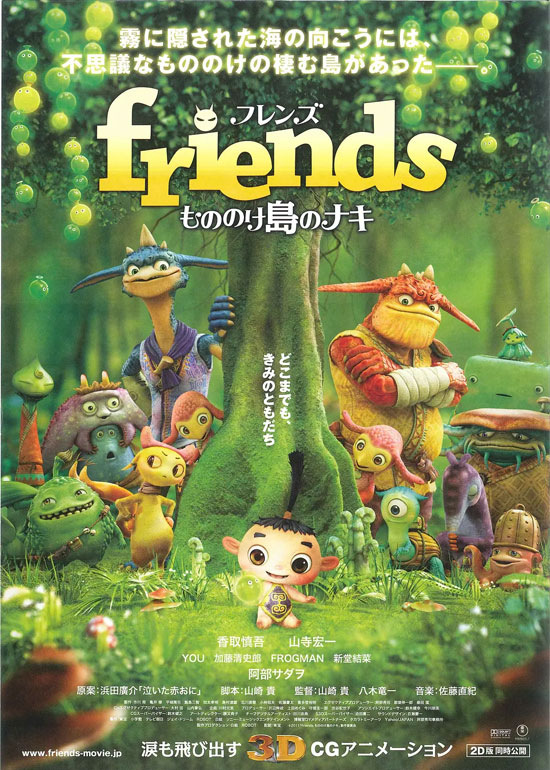Film Name: 朋友:怪物岛的纳基 / Friends: Naki on Monster Island

Released in 2011, “Friends: Naki on Monster Island” stands as one of Japan’s most representative fully CG-animated films outside of game adaptations. While most Japanese animations deliberately employ a 2D aesthetic even when utilizing 3D CG technology, this film—alongside later works like the ‘Doraemon’ CG movies and “Legend of Sanctuary”—can be seen as part of a shared lineage, establishing a distinct visual experience within Japanese animation. Perhaps in the near future, we will gradually become more familiar with this fully CG-rendered state of Japanese animation.
Returning to the film itself, this adaptation of Hirosuke Hamada’s renowned children’s book “Cry of the Red Ghost” showcases the textual power of excellent children’s literature. While domestic children’s animations abound, few truly resonate through their scripts—often forcing melancholy or merely paying lip service to sorrow, while neglecting the authentic, heartfelt essence of human relationships. Watching this film primarily offers lessons in crafting genuinely moving character dynamics.
At its core, the film tells a story of racial misunderstanding evolving into mutual understanding, portraying monsters whose terrifying, grotesque exteriors conceal beautiful inner worlds. It establishes a foundational worldview where humans and monsters live in mutual fear and hatred, yet neither side is inherently evil—they simply need an opportunity to understand each other. And this chance truly emerges through a series of fortuitous events. A human infant accidentally ends up on the monsters’ island, becoming the key to unlocking the hearts of both races.
Choosing an infant as the mediator couldn’t be more fitting. Untainted by the rigid preconceptions of the adult world, the child sees the world and acts with pure, uncomplicated motives. It is precisely this innocence that gradually melts the Red Ogre’s hatred and fear toward humans. When the Red Ogre voluntarily returned to the human village to deliver the baby mushroom to the infant, his polite and humble demeanor at the village entrance, along with his sincere desire for peaceful coexistence, truly moved one to appreciate all the kindness in the world. Of course, obstacles to progress often stem not from external forces but from within—from entrenched misconceptions and the executioner-like nature of a few individuals. The film portrays all humans except the infant with a self-deprecating tone: they are weak yet prone to stirring trouble, ignorant yet full of self-importance.
The audience’s focus shifts from the infant to the Red Oni, transitioning from being captivated by the baby’s innocence to being drawn to the Red Oni’s humanity. Overall, this stems from a psychological inclination to care for the vulnerable. On Monster Island, the infant represents the underdog—the sole human, physically frail, and seemingly vulnerable to being crushed by monsters at any moment. Yet he manages to survive unscathed. In the human village, the Red Oni becomes the underdog. Though powerful, he is outnumbered and, burdened by childhood trauma, constantly plays the weakling. Yet he wins over the humans. Driven by sympathy and the psychological need to protect the vulnerable, the audience naturally embraces these two classic underdog-turned-hero narratives.
The Red Oni and Blue Oni’s ending is unexpectedly moving—even more so than the bond between the Red Oni and the infant. This impact stems from an early emotional setup: the Red Oni vowing never to cry again in this lifetime. From that moment, audiences anticipate what could possibly break this oath, knowing it must be profoundly touching. True to form, it is the Blue Oni’s self-sacrificing friendship. The ending crafted for Blue Oni, though not a conventional happy ending, surpasses one in its impact. When Blue Oni’s signature movement appears on the beach, you understand his intent and feel Red Oni’s emotions—everything is conveyed without words, leaving only tears streaming down your face.
The film’s use of echoing symbols is textbook-perfect. Every meaningful motif appears at least twice, but never more than three times. Take the collapsed house of the Bitter Melon Demon, the Celestial Mushroom and Transformation Mushroom, the Blue Oni’s branch gesture, the infant’s spoon… Each is deployed with precision to evoke audience resonance without becoming tedious. Truly masterful.
Please specify:Anime Phone Cases » Friends: Naki on Monster Island 2011 Animation Film Review: Underdog Comeback